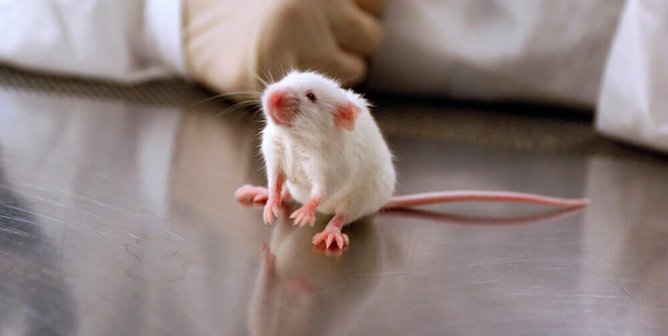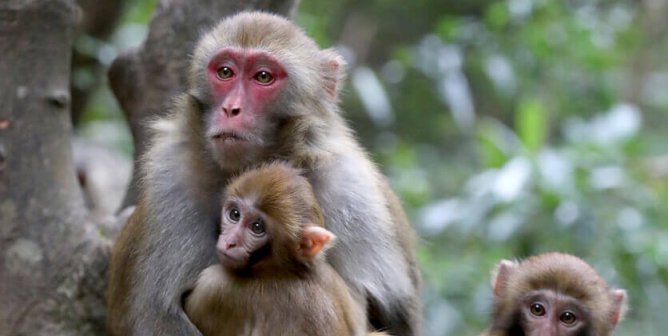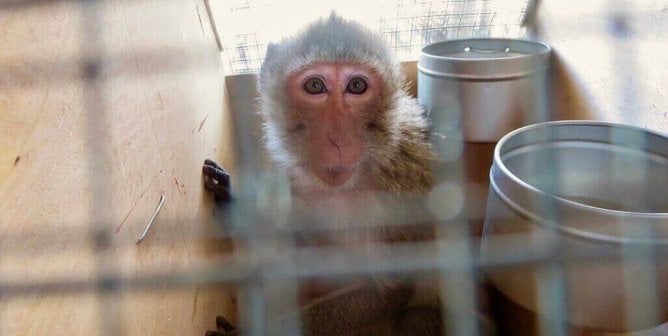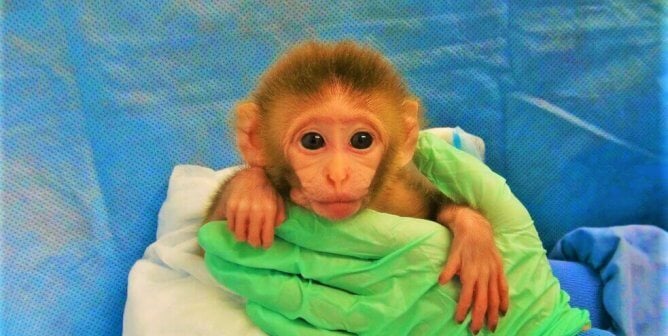Facts and Statistics About Animal Testing
Each year, more than 110 million animals—including mice, rats, frogs, dogs, cats, rabbits, hamsters, guinea pigs, monkeys, fish, and birds—are killed in U.S. laboratories for biology lessons, medical training, curiosity-driven experimentation, and chemical, drug, food, and cosmetics testing. Before their deaths, some are forced to inhale toxic fumes, others are immobilized in restraint devices for hours, some have holes drilled into their skulls, and others have their skin burned off or their spinal cords crushed. In addition to the torment of the actual experiments, animals in laboratories are deprived of everything that is natural and important to them—they are confined to barren cages, socially isolated, and psychologically traumatized. The thinking, feeling animals who are used in experiments are treated like nothing more than disposable laboratory equipment.
Animal Experiments Are Wasteful and Unreliable
A Pew Research Center poll found that 52 percent of U.S. adults oppose the use of animals in scientific research, and other surveys suggest that the shrinking group that does accept animal experimentation does so only because it believes it to be necessary for medical progress.5,6 The majority of animal experiments do not contribute to improving human health, and the value of the role that animal experimentation plays in most medical advances is questionable.
In an article published in The Journal of the American Medical Association, researchers found that medical treatments developed in animals rarely translated to humans and warned that “patients and physicians should remain cautious about extrapolating the finding of prominent animal research to the care of human disease … poor replication of even high-quality animal studies should be expected by those who conduct clinical research.”7
Diseases that are artificially induced in animals in a laboratory, whether they be mice or monkeys, are never identical to those that occur naturally in human beings. And because animal species differ from one another biologically in many significant ways, it becomes even more unlikely that animal experiments will yield results that will be correctly interpreted and applied to the human condition in a meaningful way.
For example, according to former National Cancer Institute Director Dr. Richard Klausner, “We have cured mice of cancer for decades, and it simply didn’t work in humans.”8 This conclusion was echoed by former National Institutes of Health (NIH) Director Dr. Elias Zerhouni, who acknowledged that experimenting on animals has been a boondoggle. “We have moved away from studying human disease in humans,” he said. “We all drank the Kool-Aid on that one, me included. … The problem is that it hasn’t worked, and it’s time we stopped dancing around the problem. … We need to refocus and adapt new methodologies for use in humans to understand disease biology in humans.”9
The data is sobering: Although at least 85 HIV/AIDS vaccines have been successful in nonhuman primate studies, as of 2015, every one has failed to protect humans.10 In one case, an AIDS vaccine that was shown to be effective in monkeys failed in human clinical trials because it did not prevent people from developing AIDS, and some believe that it made them more susceptible to the disease. According to a report in the British newspaper The Independent, one conclusion from the failed study was that “testing HIV vaccines on monkeys before they are used on humans, does not in fact work.”11
These are not anomalies. The National Institutes of Health has stated, “Therapeutic development is a costly, complex and time-consuming process. The average length of time from target discovery to approval of a new drug is about 14 years. The failure rate during this process exceeds 95 percent, and the cost per successful drug can be $1 billion or more.”12
Research published in the journal Annals of Internal Medicine revealed that universities commonly exaggerate findings from animal experiments conducted in their laboratories and “often promote research that has uncertain relevance to human health and do not provide key facts or acknowledge important limitations.”13 One study of media coverage of scientific meetings concluded that news stories often omit crucial information and that “the public may be misled about the validity and relevance of the science presented.”14 Because experimenters rarely publish results of failed animal studies, other scientists and the public do not have ready access to information on the ineffectiveness of animal experimentation.
Funding and Accountability
Through their taxes, charitable donations, and purchases of lottery tickets and consumer products, members of the public are ultimately the ones who—knowingly or unknowingly—fund animal experimentation. One of the largest sources of funding comes from publicly funded government granting agencies such as NIH. Approximately 47 percent of NIH-funded research involves experimentation on animals, and in 2020, NIH budgeted nearly $42 billion for research and development.15,16 In addition, many charities––including the March of Dimes, the American Cancer Society, and countless others—use donations to fund experiments on animals. One-third of the projects funded by the National Multiple Sclerosis Society involve animal experimentation.17
Despite the vast amount of public funds being used to underwrite animal experimentation, it is nearly impossible for the public to obtain current and complete information regarding the animal experiments that are being carried out in their communities or funded with their tax dollars. State open-records laws and the U.S. Freedom of Information Act can be used to obtain documents and information from state institutions, government agencies, and other federally funded facilities, but private companies, contract labs, and animal breeders are exempt. In many cases, institutions that are subject to open-records laws fight vigorously to withhold information about animal experimentation from the public.18
Oversight and Regulation
Despite the countless animals killed each year in laboratories worldwide, most countries have grossly inadequate regulatory measures in place to protect animals from suffering and distress or to prevent them from being used when a non-animal approach is readily available. In the U.S., the species most commonly used in experiments (mice, rats, birds, fish, reptiles, and amphibians) comprise 99% of all animals in laboratories but are specifically exempted from even the minimal protections of the federal Animal Welfare Act (AWA).19,20 Many laboratories that use only these species are not required by law to provide animals with pain relief or veterinary care, to search for and consider alternatives to animal use, to have an institutional committee review proposed experiments, or to be inspected by the U.S. Department of Agriculture (USDA) or any other entity. Some estimates indicate that as many as 800 U.S. laboratories are not subject to federal laws and inspections because they experiment exclusively on mice, rats, and other animals whose use is largely unregulated.21
As for the more than 11,000 facilities that the USDA does regulate (of which more than 1,200 are designated for “research”), only 120 USDA inspectors are employed to oversee their operations.22 Reports have repeatedly concluded that even the minimal standards set forth by the AWA are not being met by these facilities, and institutionally based oversight bodies, called Institutional Animal Care and Use Committees (IACUCs), have failed to carry out their mandate. A 1995 report by the USDA’s Office of the Inspector General (OIG) “found that the activities of the IACUCs did not always meet the standards of the AWA. Some IACUCs did not ensure that unnecessary or repetitive experiments would not be performed on laboratory animals.”23 In 2000, a USDA survey of the agency’s laboratory inspectors revealed serious problems in numerous areas, including “the search for alternatives [and] review of painful procedures.”24 A September 2005 audit report issued by the OIG found ongoing “problems with the search for alternative research, veterinary care, review of painful procedures, and the researchers’ use of animals.”25 In December 2014, an OIG report documented continuing problems with laboratories failing to comply with the minimal AWA standards and the USDA’s weak enforcement actions failing to deter future violations. The audit highlighted that from 2009 to 2011, USDA inspectors cited 531 experimentation facilities for 1,379 violations stemming from the IACUCs’ failure to adequately review and monitor the use of animals. The audit also determined that in 2012, the USDA reduced its penalties to AWA violators by an average of 86 percent, even in cases involving animal deaths and egregious violations.26
Research co-authored by PETA documented that, on average, animal experimenters and laboratory veterinarians comprise a combined 82 percent of the membership of IACUCs at leading U.S. institutions. A whopping 98.6 percent of the leadership of these IACUCs was also made up of animal experimenters. The authors observed that the dominant role played by animal experimenters on these committees “may dilute input from the few IACUC members representing animal welfare and the general public, contribute to previously-documented committee bias in favor of approving animal experiments and reduce the overall objectivity and effectiveness of the oversight system.”27 Even when facilities are fully compliant with the law, animals who are covered can be burned, shocked, poisoned, isolated, starved, forcibly restrained, addicted to drugs, and brain-damaged. No procedures or experiments, regardless of how trivial or painful they may be, are prohibited by federal law. When valid non-animal research methods are available, no federal law requires experimenters to use such methods instead of animals.
Alternatives to Animal Testing
A high-profile study published in the prestigious BMJ (formerly British Medical Journal) documenting the ineffectiveness and waste of experimentation on animals concluded that “if research conducted on animals continues to be unable to reasonably predict what can be expected in humans, the public’s continuing endorsement and funding of preclinical animal research seems misplaced.”28
Research with human volunteers, sophisticated computational methods, and in vitro studies based on human cells and tissues are critical to the advancement of medicine. Cutting-edge non-animal research methods are available and have been shown time and again to be more accurate than crude animal experiments.29 However, this modern research requires a different outlook, one that is creative and compassionate and embraces the underlying philosophy of ethical science. Human health and well-being can also be promoted by adopting nonviolent methods of scientific investigation and concentrating on the prevention of disease before it occurs, through lifestyle modification and the prevention of further environmental pollution and degradation. The public is becoming more aware and more vocal about the cruelty and inadequacy of the current research system and is demanding that tax dollars and charitable donations not be used to fund experiments on animals.
History of Animal Testing
PETA created “Without Consent”—an interactive timeline featuring almost 200 stories of animal experiments from the past century—to open people’s eyes to the long history of suffering that’s been inflicted on nonconsenting animals in laboratories and to challenge people to rethink this exploitation. Visit “Without Consent” to learn more about harrowing animal experiments throughout history and how you can help create a better future for living, feeling beings.
You Can Help Stop Animal Testing
Virtually all federally funded research is paid for with your tax dollars. Your lawmakers needs to know that you don’t want your money used to pay for animal experiments.
Urge your members of Congress to endorse PETA’s Research Modernization Deal, which provides a roadmap for modernizing U.S. investment in research by ending funding for useless experiments on animals and investing in effective research that’s relevant to humans.
Animal Testing Facts and Figures
U.S. (2022)1,2
- In 2022, more than 1.27 million animals were held captive in laboratories or used in experiments, excluding rats, mice, birds, reptiles, amphibians, and agricultural animals used in agricultural experiments. The number of mice and rats is estimated to have been 111 million.
Canada (2022)3
- Institutions certified by the Canadian Council on Animal Care (CCAC) reported that 3.52 million animals were used in experiments in 2022.*
- Of these, 105,253 animals were subjected to “severe pain near, at, or above the pain tolerance threshold of unanesthetized conscious animals.”
*The CCAC is a “national peer-review organization” funded by the Canadian government but with no regulatory capacity. Only institutions that receive public funds are required to be certified by the CCAC, and the figures reported by the organization reflect only this subset of facilities. Most private research facilities are not certified by the CCAC, and their use of animals is therefore not included in the organization’s figures.
U.K. (2023)4
- In 2023, 2.68 million procedures were conducted on animals.
- Of those, 80,400 were assessed to be “severe,” including “long-term disease processes where assistance with normal activities such as feeding and drinking are required, or where significant deficits in behaviours/activities persist.”
References
1Data from all 2022 annual reports was derived from the U.S. Department of Agriculture’s public search tool.
2Larry Carbone, “Estimating Mouse and Rat Use in American Laboratories by Extrapolation From Animal Welfare Act–Regulated Species,” Scientific Reports 11, 493 (2021).
3CCAC, “CCAC Animal Data Report 2022,” 2023.
4U.K. Government, “Annual Statistics of Scientific Procedures on Living Animals, Great Britain 2023,” Home Office, September 11, 2024.
5Cary Funk and Meg Hefferon, “Most Americans Accept Genetic Engineering of Animals That Benefits Human Health, but Many Oppose Other Uses,” Pew Research Center, 16 Aug. 2018
6Peter Aldhous and Andy Coghlan, “Let the People Speak,” New Scientist 22 May 1999.
7Daniel G. Hackam, M.D., and Donald A. Redelmeier, M.D., “Translation of Research Evidence From Animals to Human,” The Journal of the American Medical Association 296 (2006): 1731-2.
8Marlene Simmons et al., “Cancer-Cure Story Raises New Questions,” Los Angeles Times 6 May 1998.
9Rich McManus, “Ex-Director Zerhouni Surveys Value of NIH Research,” NIH Record 21 June 2013.
10Jarrod Bailey, “An Assessment of the Role of Chimpanzees in AIDS Vaccine Research,” Alternatives to Laboratory Animals 36 (2008): 381-428.
11Steve Connor and Chris Green, “Is It Time to Give Up the Search for an AIDS Vaccine?” The Independent 24 Apr. 2008.
12National Institutes of Health, “About New Therapeutic Uses,” National Center for Advancing Translational Sciences 9 Oct. 2019.
13Steve Woloshin, M.D., M.S., et al., “Press Releases by Academic Medical Centers: Not So Academic?” Annals of Internal Medicine 150 (2009): 613-8.
14Steven Woloshin and Lisa Schwartz, “Media Reporting on Research Presented at Scientific Meetings: More Caution Needed,” The Medical Journal of Australia 184 (2006): 576-80.
15Diana E. Pankevich et al., “International Animal Research Regulations: Impact on Neuroscience Research,” The National Academies (2012).
16National Institutes of Health, “Budget,” (last accessed on 3 May 2021).
17Pankevich et al.
18Deborah Ziff, “On Campus: PETA Sues UW Over Access to Research Records,” Wisconsin State Journal 5 Apr. 2010.
19U.S. Department of Agriculture, Animal and Plant Health Inspection Service, “Animal Welfare, Definition of Animal,” Federal Register, 69 (2004): 31513-4.
20Justin Goodman et al., “Trends in Animal Use at US Research Facilities,” Journal of Medical Ethics 0(2015): 1-3.
21The Associated Press, “Animal Welfare Act May Not Protect All Critters,” 7 May 2002.
22U.S. Department of Agriculture, Animal and Plant Health Inspection Service, “Animal Care: Search.”
23U.S. Department of Agriculture, Office of Inspector General, “APHIS Animal Care Program, Inspection and Enforcement Activities,” audit report, 30 Sept. 2005.
24U.S. Department of Agriculture, Animal and Plant Health Inspection Service, “USDA Employee Survey on the Effectiveness of IACUC Regulations,” Apr. 2000.
25U.S. Department of Agriculture, Office of Inspector General, “APHIS Animal Care Program, Inspection and Enforcement Activities,” audit report, 30 Sept. 2005.
26U.S. Department of Agriculture, Office of Inspector General, “Animal and Plant Health Inspection Service Oversight of Research Facilities,” audit report, Dec. 2014.
27Lawrence A. Hansen et al., “Analysis of Animal Research Ethics Committee Membership at American Institutions,” Animals 2 (2012): 68-75.
28Pandora Pound and Michael Bracken, “Is Animal Research Sufficiently Evidence Based To Be A Cornerstone of Biomedical Research?,” BMJ (2014): 348.
29Junhee Seok et al., “Genomic Responses in Mouse Models Poorly Mimic Human Inflammatory Diseases,” Proceedings of the National Academy of Sciences 110 (2013): 3507-12.









